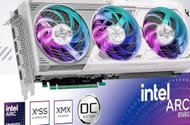The Intel Arc B580 12 GB and the Nvidia RTX 3060 Ti 8 GB have positioned themselves to be prime options in the entry-level 1080p gaming market. With a competitive $249 tag, Intel's newest release provides a fantastic price-to-performance ratio. While Nvidia's 3060 Ti is no more a new GPU, it continues to be powerful for entry-level and mid-range gaming. You can still expect high framerates from the card in the latest titles with little to no performance hiccups.
In today's market, the B580 and the 3060 Ti aren't that far apart. The Nvidia GPU has been sufficiently discounted to keep up with the latest launches. Moreover, you can buy it for much cheaper in the used market. This raises the question: which of these two pixel pushers is the better purchase? Let's try to answer that.
Note: Parts of this article are based on the author's opinion.
The Intel Arc B580 12 GB and Nvidia RTX 3060 Ti 8 GB target the entry-level gaming market

The on-paper specs won't reveal much about the two GPUs, given they are based on wildly different architectures. While the Arc B580 is powered by the new Battlemage architecture from Team Blue, the 3060 Ti packs the older Ampere technology. Thus, even for similar spec sheets, the two GPUs may perform quite differently.
Specs comparison
The Intel Arc B580 is based on the BMG-G21 graphics chip, which is the only offering in the new Battlemage lineup. The latest technology is based on a new 5nm fabrication process from TSMC. This is a step up from the 8nm process used by Nvidia Ampere. You get 20 Xe2 cores with this chip, each offering up to 50% more performance than the last generation, as per Intel. You also get 160 tensor cores (these cores aren't the same as Nvidia's Tensor) and 20 ray tracing cores.
The RTX 3060 Ti is a vastly different card in terms of the underlying hardware. You get the GA104 graphics chip, which is a cut-down version of the GA102 and GA103 processors used by higher-end cards. The card packs 4,864 CUDA cores, 152 Tensor cores, and 38 RT cores.
In terms of VRAM capacity, the Intel card has the upper hand with 12 GB GDDR6 memory. Despite having a smaller 8 GB GDDR6 buffer, the card has a higher bus width, which translates to roughly equal memory bandwidth for the two GPUs. They also share similar power draw numbers, with the B580 rated at 190W and the 3060 Ti drawing 200W under maximum load.
The detailed specs lists for the cards are as follows:
Coming to the prices, the Arc B580 is the cheaper GPU, priced at just $249 at launch. The 3060 Ti initially launched for $399 and is currently selling for $330-$350. You can get better deals in the used market.
Read more: Intel Arc B580 vs Arc A770
Performance comparison

Coming to the performance differences between the two graphics cards, quite some differences between them translate to a very nuanced framerate difference in the latest titles. The B580 takes the lead in some games, while the RTX 3060 Ti has the upper hand in a few others due to better optimization.
Below is a list of framerates achieved by the two cards in some of the latest games. These numbers have been recorded at 1080p resolutions and were sourced from the YouTube channel Testing Games.
On average, the 3060 Ti is 0.76% slower than the B580. This is within the margin of error, so we can consider the two cards about as powerful as each other. However, we believe that with further driver optimizations, the Arc GPU should be able to close the gap in titles like Assassins' Creed Valhalla and A Plague Tale: Requiem. The card simply can't pull off better performance consistently across workloads, which is quite concerning.
Overall, the Arc B580 12 GB emerges as the clear winner in this comparison. While the GPU isn't any faster than the Nvidia card, it brings slightly better power efficiency, more VRAM, and a much cheaper price tag. However, you'll miss out on DLSS and ray tracing performance with the Intel card.
